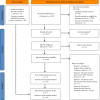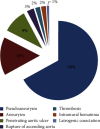Minimally Invasive Endovascular Repair for Nondissected Ascending Aortic Disease: A Systematic Review
- PMID: 37767197
- PMCID: PMC10522436
- DOI: 10.1155/2023/5592622
Minimally Invasive Endovascular Repair for Nondissected Ascending Aortic Disease: A Systematic Review
Abstract
Objective: The aim of this study is to evaluate the efficacy of endovascular treatment for nondissected diseases of the ascending aorta. Data Sources. PubMed, Embase, and SciELO. Review Methods. In this study, we conducted a search on the PubMed, Embase, and SciELO databases for all cases of ascending aortic endovascular repair included in the literature published between January 2007 and July 2023, excluding type A aortic dissection. We reviewed 56 case reports and 7 observational studies included in this study, assessing the techniques, equipment, procedural steps, and results. We summarized the age, complications, follow-up time, and access route.
Results: This study includes 63 articles reporting 105 patients (mean age: 64.96 ± 17.08 years) who received endovascular repair for nondissected ascending aortic disease. The types of disease include aneurysm (N = 16), pseudoaneurysm (N = 71), penetrating aortic ulcer (N = 10), intramural hematoma (N = 2), thrombosis (N = 2), iatrogenic coarctation (N = 1), and rupture of the aorta (N = 3). The success rate of surgery is 99.05% (104/105). Complications include endoleak (10.48%, 11/105), stroke (5.71%, 6/105), postoperative infection (1.91%, 2/105), acute renal failure (0.95%, 1/105), aortic rupture (0.95%, 1/105), thrombosis (0.95%, 1/105), and splenic infarction (0.95%, 1/105). Five patients required conversion to open surgery, two patients underwent endovascular reintervention, and four of these five patients underwent surgery due to endoleak. Early mortality was 2.86% (3/105).
Conclusion: While the viability and results of endovascular repair for the treatment of ascending aortic disease are acknowledged in some circumstances, further research is needed to determine the safety and effectiveness of endovascular treatment for ascending aortic disease.
Copyright © 2023 Weixue Huo et al.
Conflict of interest statement
The authors declare that they have no conflicts of interest.
Figures
Similar articles
-
Endovascular treatment of non-dissected ascending aorta disease: a systematic review.Eur J Cardiothorac Surg. 2018 Feb 1;53(2):317-324. doi: 10.1093/ejcts/ezx308. Eur J Cardiothorac Surg. 2018. PMID: 28958041
-
Fenestrated endovascular grafts for the repair of juxtarenal aortic aneurysms: an evidence-based analysis.Ont Health Technol Assess Ser. 2009;9(4):1-51. Epub 2009 Jul 1. Ont Health Technol Assess Ser. 2009. PMID: 23074534 Free PMC article.
-
Catheter-based treatment of the dissected ascending aorta: a systematic review.Eur J Cardiothorac Surg. 2021 Jan 4;59(1):80-91. doi: 10.1093/ejcts/ezaa238. Eur J Cardiothorac Surg. 2021. PMID: 32893292
-
[Endovascular repair of primary retrograde Stanford type A aortic dissection].Zhonghua Wai Ke Za Zhi. 2016 Oct 1;54(10):761-765. doi: 10.3760/cma.j.issn.0529-5815.2016.10.008. Zhonghua Wai Ke Za Zhi. 2016. PMID: 27686640 Chinese.
-
[Outcomes of endovascular repairing aortic arch disease hybrid with supra-arch debranching procedures].Zhonghua Wai Ke Za Zhi. 2015 Nov 1;53(11):826-30. Zhonghua Wai Ke Za Zhi. 2015. PMID: 26813836 Chinese.
References
Publication types
LinkOut - more resources
Full Text Sources




